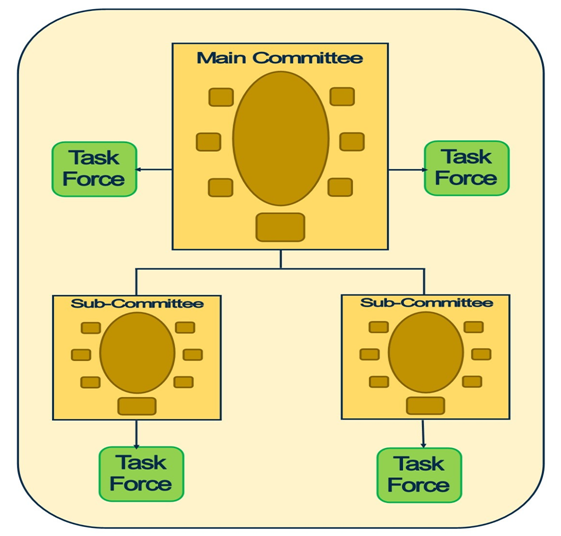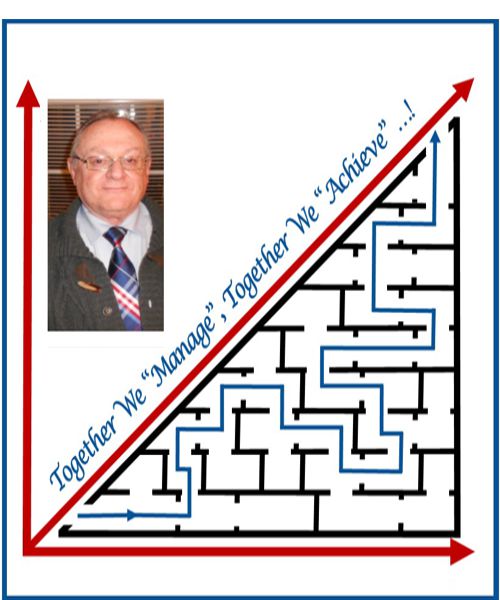Viewpoint
» On "Teaching"
» On "Learning"
» On "Knowledge"
» On "Goals"
» On "Time"
» On “Management”
» On “Reading”
» On "Committees"
» On "A Place to Visit"
» On "Human Resources"
» On "Progress & Development"
» On "History"
» On "Public Speaking"
» On "Organizing"
» On "Motivation"
» On "Teams"
» On "Communication"
» On "Management Coaching"
» On "Traveling"


On "Committees"
By Adel J. Helou
A committee is a group of people that come together to look after and manage a specific task, activity, or function. Committees can be found in many different businesses and social environments. Most of the time - but not always - Committees are of the following types:
- Managing, developing, and monitoring product specifications.
- Materials and measurement standards.
- Health/safety procedures.
- Monitoring, analyzing and evaluating climate change.
- Economic and financial trends of a community ... etc.
To have an effective committee it may be preferable for it to be:
- Small in size (say 7 members)
- Made up of members knowledgeable in the field of concern
- Made up of an odd number (3, 5, 7, …, etc.) of members
Small number committees are more goal oriented and spend their time discussing the topic or issue of concern. As for a committee of specialists and knowledgeable members, it can reach results through focused and useful discussions. The above two points help minimize waste of time and lead to attaining the goals quickly. The benefit of having an odd number of members (7 members for example) come up when there is a need for a vote on a motion. In a voting situation it is wise to have a person (the chairman of the committee) to break the tie, in the event there is one. In a seven members committee you may get three members vote for a motion and three members vote against that motion. In this case the chairman, who would vote last, can break the tie, one way or the other, or ask for more study, if he deems it necessary.
Committees usually meet on a scheduled basis. They may meet once a month, once a quarter, twice a year, or once a year, depending on their functions and activities at hand. In a meeting the chairman would assign one of the members to write the minutes of the meeting. The chairman would also state the topic of discission for the meeting. Having declared the topic, he would go around the table allowing each member to state his/her ideas or opinions on the matter. Minutes of the meeting should show all input as stated. The chairman would then open the discussion of the topic. Under the direction of the chairman each member in turn, when asked, would make his/her statement, and develop his/her point of view. Statements are better addressed to the chairman allowing him/her to field the issue back to the members as questions or points for clarification. The benefit of such a procedure is to avoid conflict between members especially if there are opposite points of view being discussed. In the event of an arising conflict the chairman would act as a moderator. All this intense interaction between members of a committee puts a heavy administrative load on the chairman, hence the validity of preference for having a small size committee of knowledgeable members.

Figure – 1
Committees, Sub-Committees, and Taskforces
Moreover, minutes of committee’s meetings are expected to be a complete record of discussions reflecting what took place. At the end of each meeting, the minutes should be reviewed with all members and obtained their approval. This is important especially when there are assigned tasks to be carried out by any member of that committee in preparation for discussion in a following meeting. Minutes of meetings are later sent to the members. Needless to say, all committee meetings should act based on a list of points (a meeting’s agenda) that would be discussed during that meeting. Such a list will help members to prepare for the meeting. The list would be distributed to the members so as to allow time for them to be prepared to discuss the various points during the meeting.
As long as an activity needs to be monitored and managed a committee will continue to exist. Members of a committee - including the chairman - can be changed. Should there be a need, sub-committees could be formed to handle special aspects of the main role or function of the main committee. It is recommended that sub-committees be formed with the minimum necessary number of members. This is to ensure that discussions remain focused on the issues and that decisions and goals are attained in the shortest time.
When necessary, both committees and sub-committees can form taskforces or study-groups. These teams (taskforces and study-groups) are called upon to assist in developing detailed, in-depth studies and analyses (see Figure – 1). Detailed studies can be technical and mathematical in nature, or they can be social in nature where community surveys are required to develop statistics and databases for use by the committees to reach decisions on matters at hand.
As demonstrated, preparing a high quality and effective committee is to ensure reaching goals successfully and on time.
Adel J Helou: is a Business and Life Management Coach. He has more than 15 years of experience in production and operations management. The Author has international professional experience in the Middle East markets. He holds a B.Sc. degree in Chemistry and Physics and an M.Sc. in Chemical Engineering. Mr. Helou has pages on Facebook, LinkedIn, Twitter, and Instagram:
facebook.com/AdelJosephHelouManagementCoach/
linkedin.com/in/adeljosephheloumanagementcoach/
Instagram.com/adel.helou
twitter.com/helou_adel
Read about his Management Coaching and the articles he writes, by visiting the electronic magazine (E-Zine): optimanage.com.
The E-Zine has a fb page: facebook.com/optimanagedotcom/.
A.J. Helou can be contacted by e-mail: a.j.helou@optimanage.com (e-mail)
linkedin.com/in/adeljosephheloumanagementcoach/
Instagram.com/adel.helou
twitter.com/helou_adel
Read about his Management Coaching and the articles he writes, by visiting the electronic magazine (E-Zine): optimanage.com.
The E-Zine has a fb page: facebook.com/optimanagedotcom/.
A.J. Helou can be contacted by e-mail: a.j.helou@optimanage.com (e-mail)




